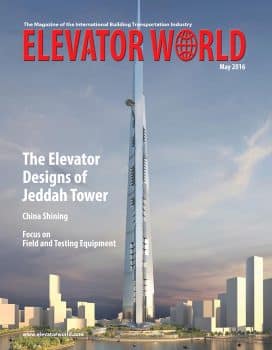Our cover this month has a certain “wow factor.” The Jeddah Tower is just in the initial stages of construction and won’t be completed until 2018. But, when it is, according to vertical-transportation equipment designer for the project and author of this article James W. Fortune, the tallest building in the world will have “the most advanced, all-digital destination dispatching, motor and motion controls” ever. To say that this building is mixed use seems an understatement — it will contain a hotel, offices, parking, residential, observation, restaurant and service areas. KONE, which won the bid, can go the distance.
ELEVATOR WORLD Associate Editor Kaija Wilkinson has written a stunning Market Trends: China Shining. Although growth is slowing in the Asian giant, China is still the world’s largest elevator and escalator market. In new installations, the OEMs expect a 5% decline this year and stabilization next year. With a mind-blowing installed base of 4.67 million, maintenance is very fragmented. In most markets, new equipment is 50%, with maintenance as the other 50%; in China, new equipment is 90% of the market. A new law, however, puts the onus for post-installation repairs directly on the installer. All OEMs are increasing local footprints to handle a rise in maintenance.
The second-fastest-growing elevator and escalator market is India, where we attended the International Elevator & Escalator Expo 2016. This event, run by our partners in producing EW India, netted more than 10,000 visitors this year with some 200 exhibitors from 22 countries. Our good friend TAK Mathews, a leading Indian consultant and former EW India editor, moderated the accompanying technical conference.
The Elevator Escalator Safety Foundation’s (EESF) AGM was held in Atlanta last month and, according to reporter EW Editorial Assistant Hanno van der Bijl, the industry-supported Foundation is undergoing a “mod job.” Following strategic planning sessions, EESF has updated programs, hired new leadership and realigned its board of regents. Check out its plans for the programs going into the 2016-2017 school year.
Our focus this month is on Field and Testing Equipment. It includes two articles on suppliers of equipment for the field, Unitec and Wurtec, which talk about how they got started. Wurtec based its 1985 beginnings on listening to mechanics in the field for what they wanted in equipment. Read the article Tools of the Trade for new ideas for the field on the horizon. Unitec got its start as an Otis parts supplier 25 years ago but now handles more than 150,000 parts for many other manufacturers. In Service and Safety, Unitec Manager Mary Beeson highlights her team and talks about its special Safety-in-a-Bag product. With all the new employees in the field, safety training is more important than ever. Paul Waters, who often defends those in our industry against OSHA citations, writes about training this month. In The Best Defense, Waters said, indeed, the only defense against OSHA citations is training and documentation. The National Elevator Industry, Inc. (NEII®) publishes training matrices (included in the article) that are the minimum of which contractors need to be aware. He also writes about two new areas to include for construction — “confined space” and “cranes and derricks.”
At a recent NEII Field Safety Committee meeting, the discussion turned to the number of new people in the industry and how that affects safety in the field. The benches are empty in most union halls, and in some focused areas like New York City (NYC), construction is going wild. (According to a recent Dodge Data & Analytics report, new construction starts in NYC are running at 34.3% ahead of last year.) There are a number of programs, like “Helmets to Hardhats,” that put an influx of new people into the field. According to the committee, this increases pressure on all companies to deal with employees eager to work and learn but not completely aware of the hazards they face in the field.
According to Engineering News-Record, U.S. construction employment is up 4.2% over last year, and unemployment is the lowest since 2000. At the same time, American General Contractors’ recent survey noted that 86% of the companies represented were having a hard time finding skilled workers, and a quarter of them reported turning down projects due to shortages.
There is little we can do to fix the current labor shortage, except continuing craft education and safety training. But for the future, Steve Binstock, president of the Construction Financial Management Association, has a serious suggestion. He says we must increase our industry’s exposure to the next generation. “Future generations are largely unaware of the abundance of opportunity that the construction industry offers. Millennials have grown up in a society that portrays a college education as the only path to success.” He suggests the various elements of the industry need to come together and “make their case” to the next generation.
Get more of Elevator World. Sign up for our free e-newsletter.









